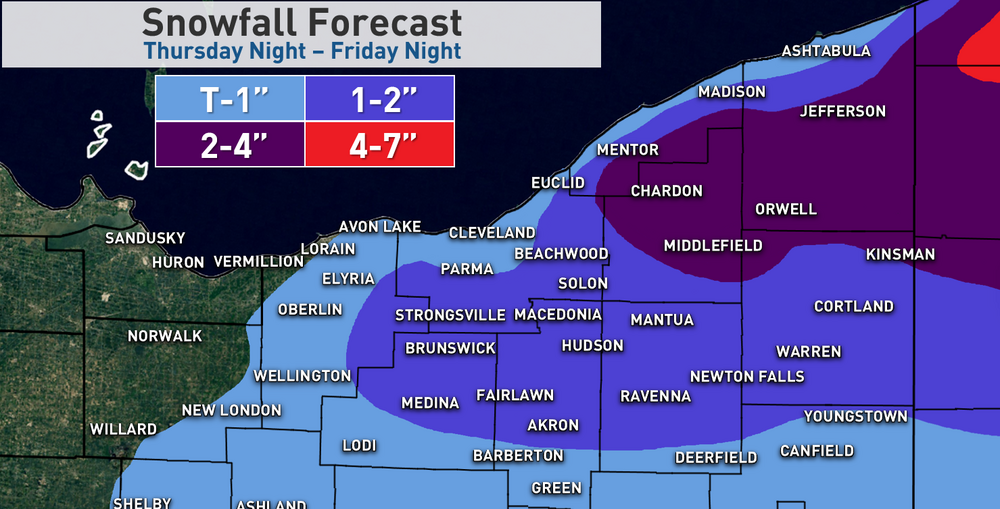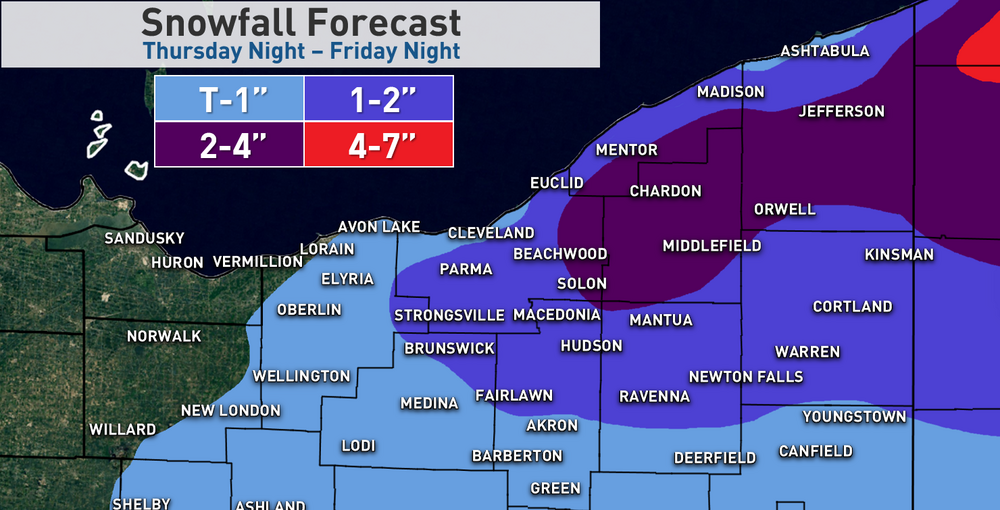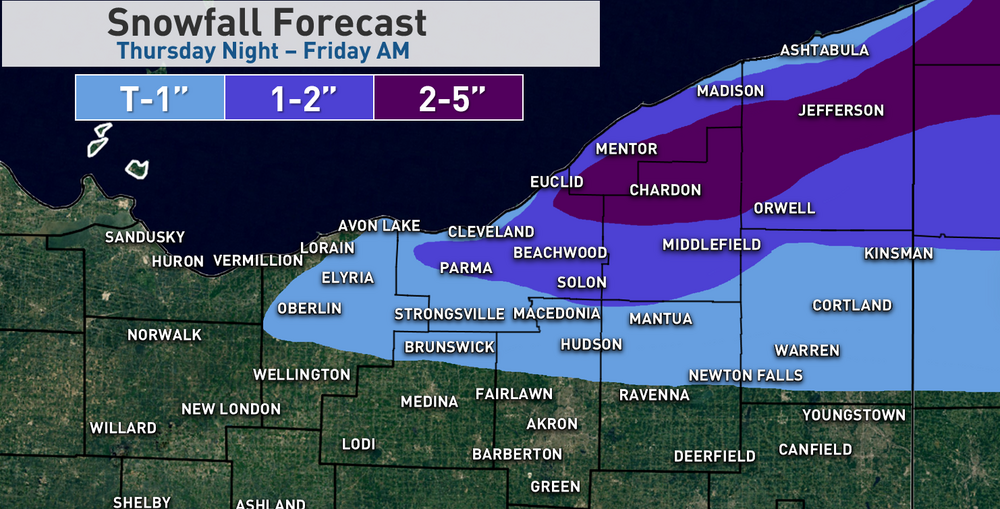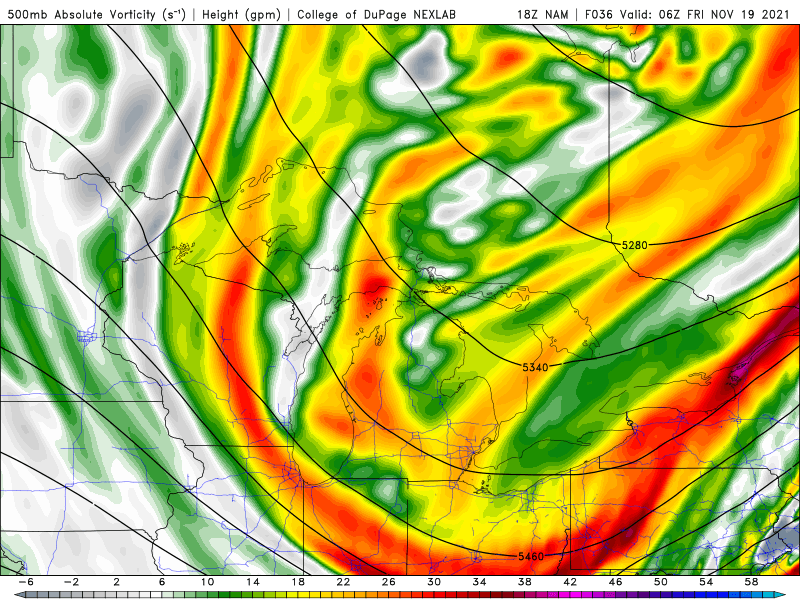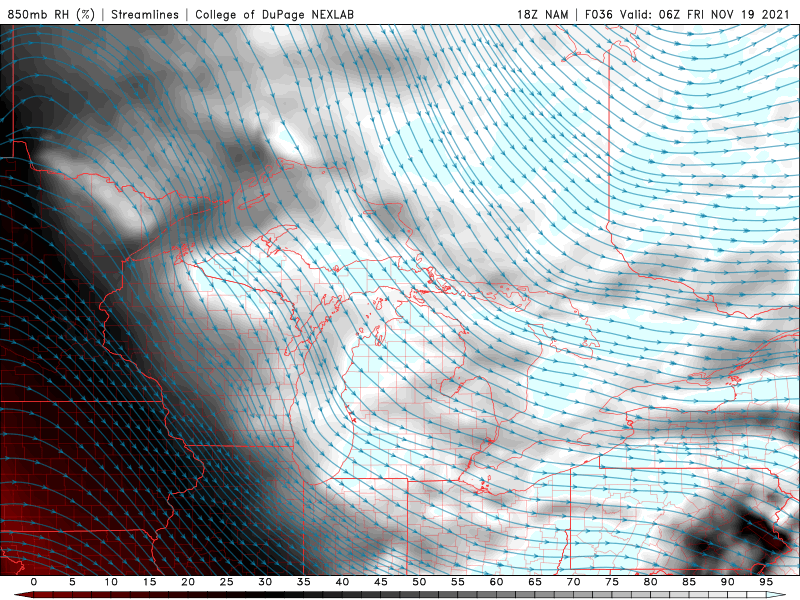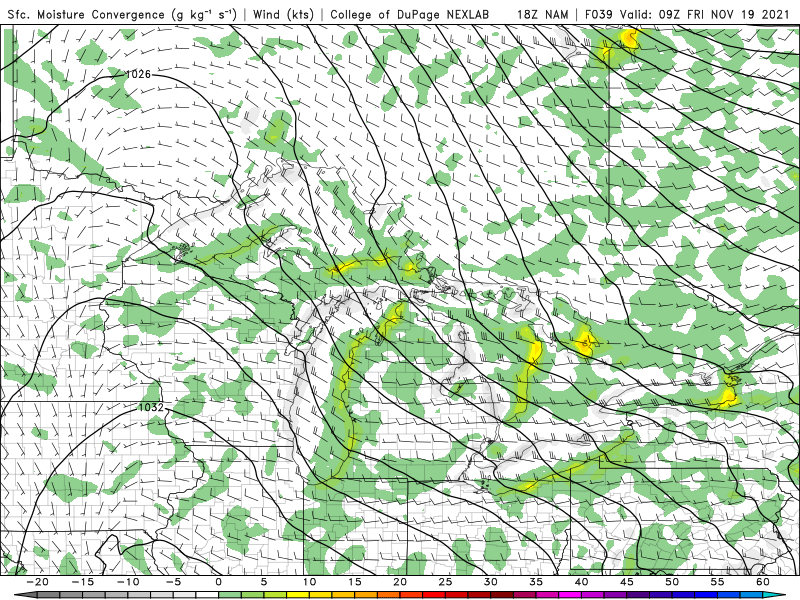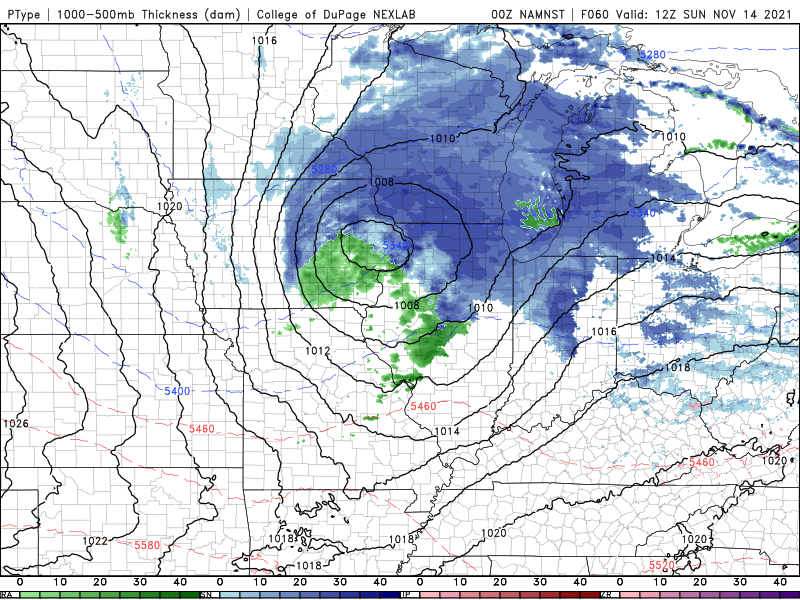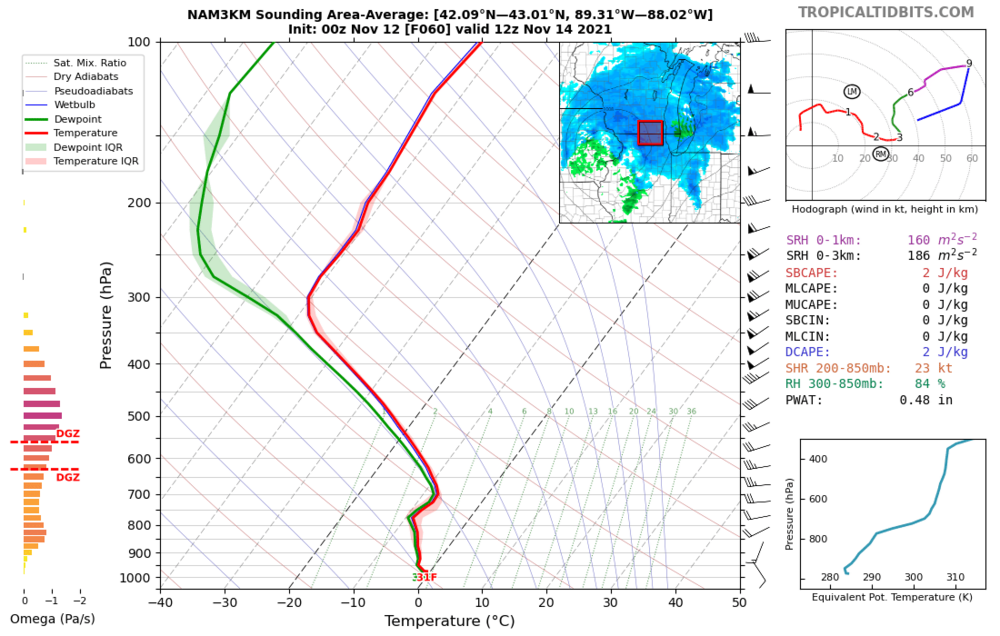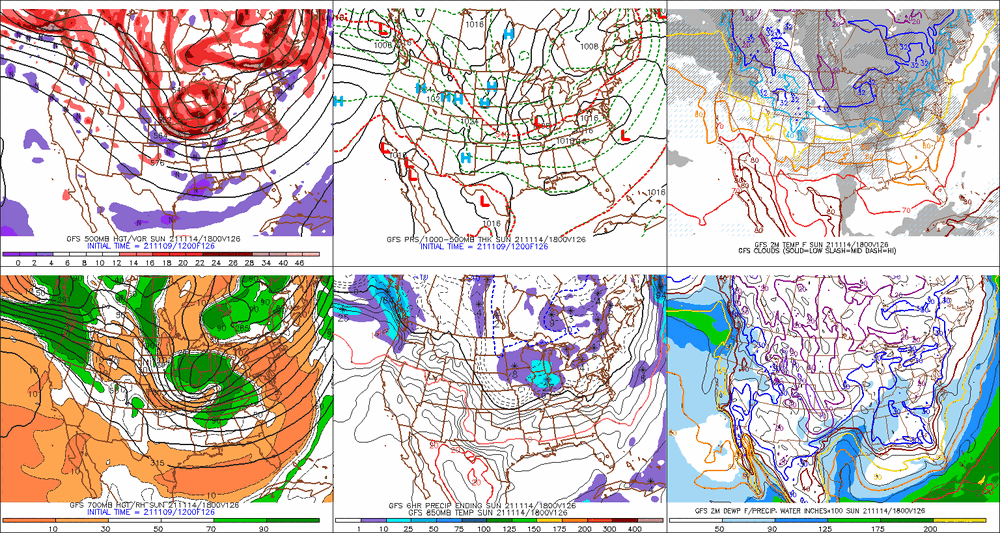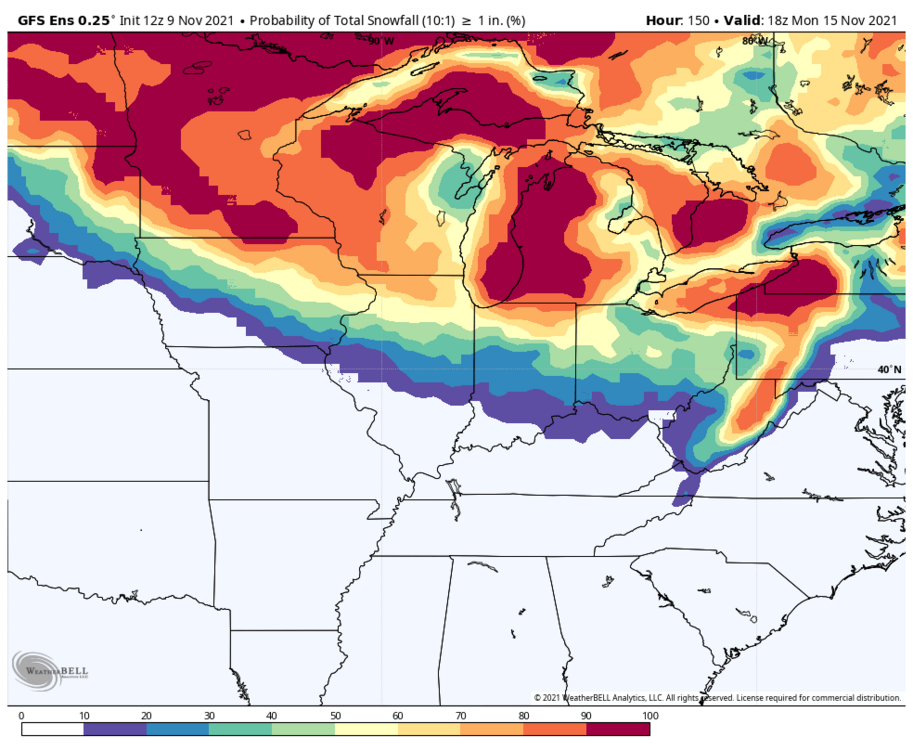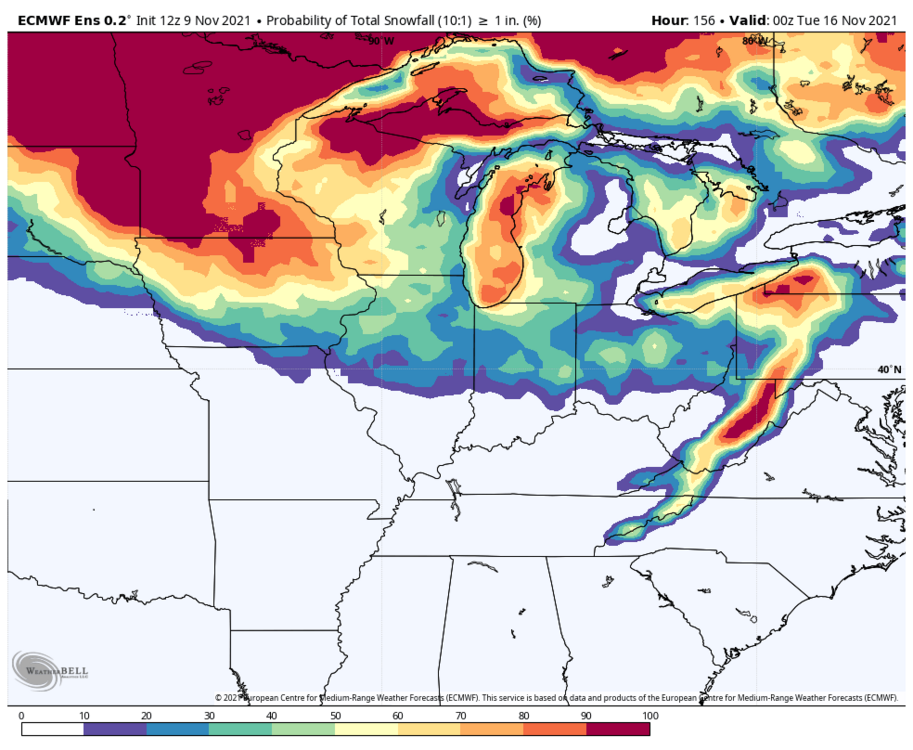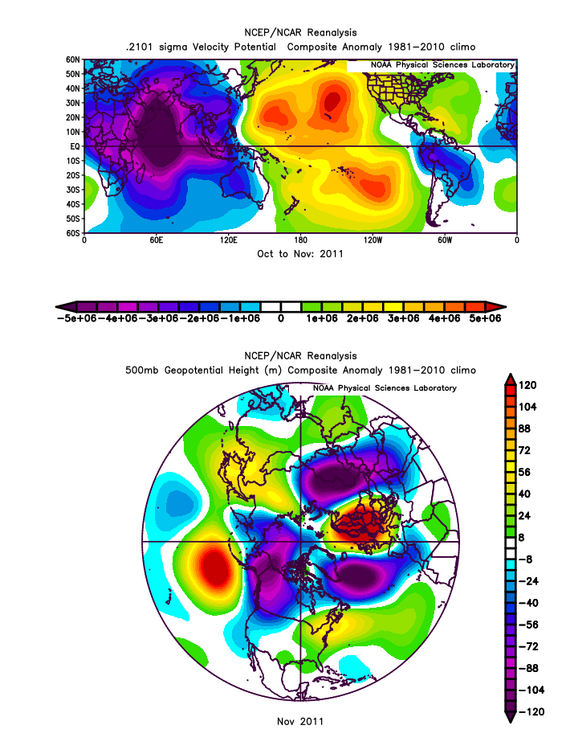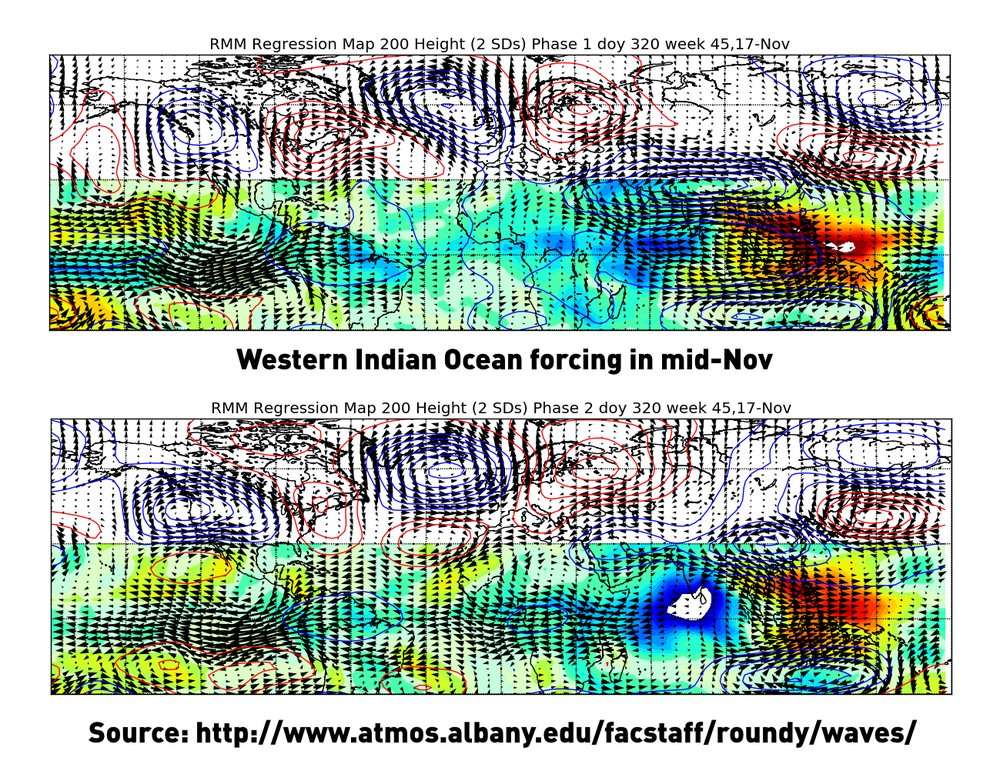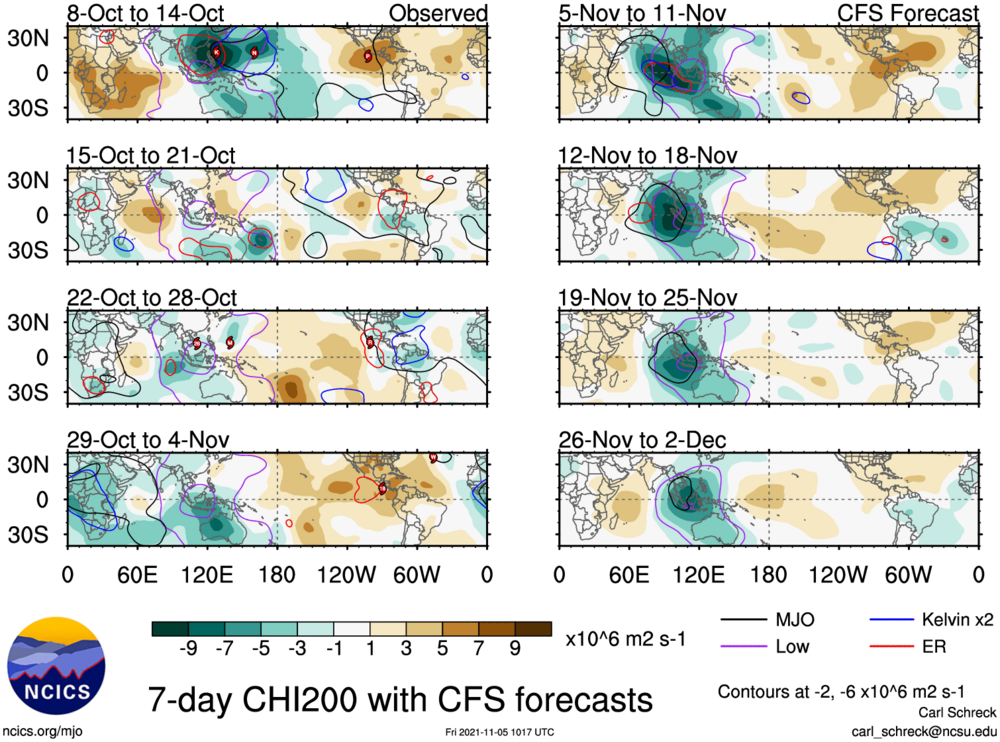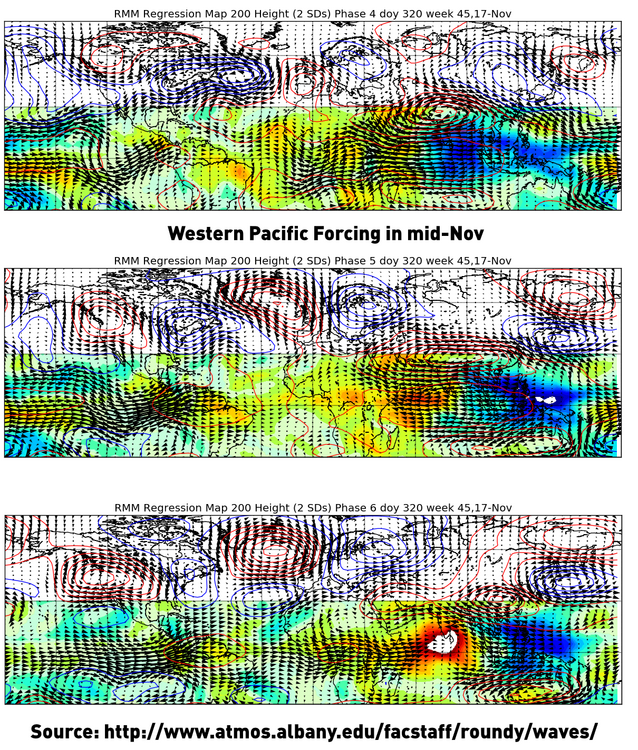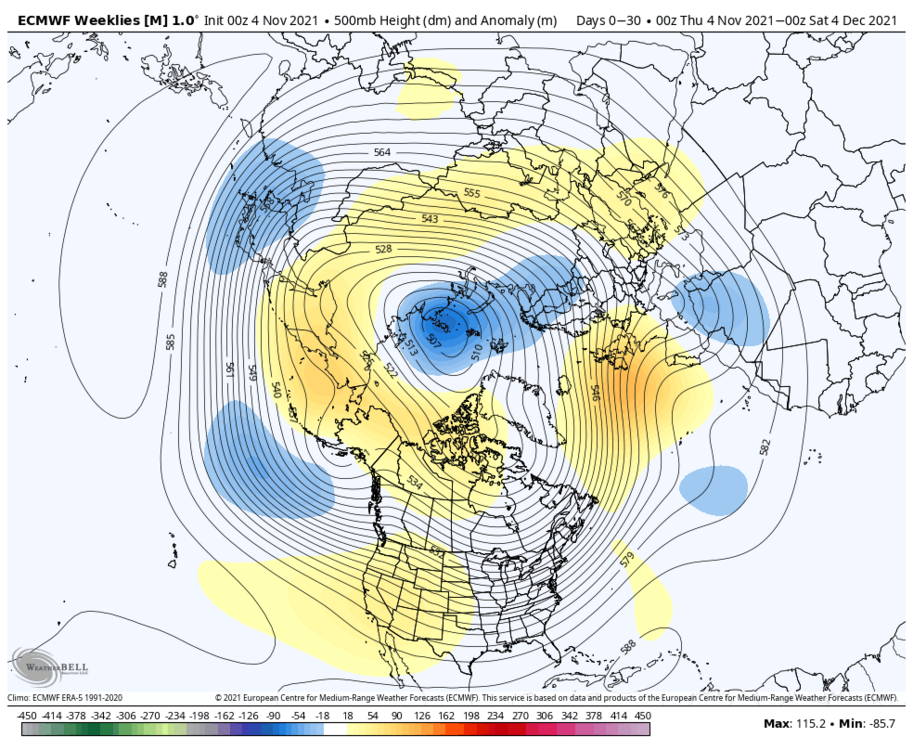
OHweather
Meteorologist-
Posts
5,004 -
Joined
-
Last visited
Content Type
Profiles
Blogs
Forums
American Weather
Media Demo
Store
Gallery
Everything posted by OHweather
-
RGEM run is pretty good for the Chagrin area with the LES
-
Looks like only a couple of spots in Geauga and Ashtaubla managed an inch in NE Ohio out of the LES...the clipper this evening seems like a safe bet to drop a quick 1-3" on NE Ohio. There's briefly good snow growth so it'll probably accumulate pretty quickly for a couple of hours this evening. The lake effect later Sunday into Sunday night looks interesting, with inversion heights and moisture depth to over 10,000 feet and synoptic support. There is a bit of shear. A Lake Huron fetch may get to at least Lake and Geauga later Sunday night too. If there was less shear this would be a candidate to overperform...even as it is a fairly widespread plowable snow is probably likely with WNW winds going NW and eventually NNW through the event.
-
Some Thoughts on the Winter 2021-22 Outlook
OHweather replied to OHweather's topic in Weather Forecasting and Discussion
I'll be happy if my concern (pessimism) from a few days ago ends up not being warranted. The long range has been tricky this fall...the EPO has tended to bust more positively than modeled, so we've been battling Pacific influence and nothing has locked in, but our cold shots have tended to trend colder as they move up in time on the models. That's happening again with the shot arriving around December 5th (with perhaps a storm in front of it): EPS: GEFS for the same timeframe: While I still think a spell of milder weather follows this shot, as the EPO remains positive and some of the current blocking in other domains relaxes, I do see some hope for a more significant EPO flip the second half of December, along with perhaps another shot for a -NAO. If things still look good I'll try to whip a post together this weekend. My thought, based on having a legitimate arctic tap of air sitting over Alaska and western Canada that has been resulting in decent, albeit fairly brief cold shots, is that if we do ever flip the EPO more negative for a period of time that we'd freeze our butts off. The current pattern could probably work for the Great Lakes and New England to get snow...it's trying a bit now and would do better closer to the heart of winter. But the current pattern would be a struggle for the Ohio Valley and Mid Atlantic even in mid-winter. For those areas to have a more legit shot we do need the +EPO to back off. -
The lake response into NE Ohio has been unimpressive so far...cloud tops have cooled a bit over the last couple of hours and radar returns have upticked a bit. There's currently a bit of synoptic lift from a vort on the backside of the upper trough, and there's another band of weak lift evident on satellite spreading across northern IN and MI ahead of another little vort that will spread across Lake Erie this afternoon and early evening before moving east. You can tell that the strong winds NEOH mentioned are having some effect, as the Pittsburgh radar shows more organized bands well inland. There are a couple of modest upstream lake connections into NE Ohio...one into Lorain, Medina, SW Summit and Stark and another into parts of Lake, Geauga, Trumbull and Mahoning. With some modest synoptic lift at times through this afternoon and winds gradually slackening, we'll see if one of these can develop into a more organized band and drop some accumulations. I suspect accumulations will be an inch or less outside of any upstream lake connections today due to the short fetch, marginal moisture, somewhat strong winds and overall borderline set-up. The hi-res models are trying to latch onto those upstream connections persisting even into the Cleveland area well into tonight...soundings don't support heavy snow, but perhaps that tacks on another local inch tonight. Overall the forecast wasn't very exciting for NE Ohio and so far there aren't signs of any big surprises going the other way. There is a strong band off of Lake Huron curling towards NW PA so I suspect they'll do fine there in the higher terrain.
-
This is a sounding from the 0z 3km NAM at 8 PM Friday in Middlesex County Mass. That'd snow good...
-
Yeah, we'll see some more 30s sneaking into the western basin after another cold few days coming up. Hopefully the lake isn't frozen by the time I move back in a couple of weeks! Probably not, but the cooling happens quick the first few cold shots each fall. Just thumbing through some models and soundings...my overall impression is that this remains a set-up that supports mainly light accumulations in NE Ohio and a bit more in NW PA and SW NY. My thoughts in NE Ohio are that the "low ends" are generally more likely than the "high ends" on my map, but that the higher-end amounts are locally attainable wherever the one or two more organized bands set-up late Thursday night into Friday morning. NW PA likely will do better overall due to more fetch, more lake warmth, somewhat higher inversions and deeper moisture, and perhaps being close to a Lake Huron connection...though in NW PA the higher amounts will still be quite tied to the hillier terrain. Yesterday, the NAM and GFS were both more progressive with the trough and had lower inversions and moisture...especially the NAM...which would have made it hard to get more than a localized inch or two in Ohio. The Canadian guidance (both the global model and the RGEM) were slower and a bit deeper with the trough and had more synoptic moisture and higher inversions, and would have supported locally more amounts even in NE OH. The Euro was somewhat in between. It seems the Euro solution will roughly come to fruition, as the NAM soundings have improved a bit since yesterday but the Canadian guidance now keeps the deeper synoptic moisture more confined to NW PA...but still supports some accumulations in NE Ohio. Even with models coming to some consensus on a middle ground solution, there are still some fairly significant differences on soundings, both model to model and between Cleveland and Erie, with respect to moisture depth and inversion heights, which may make a big difference in snow quality and rates. The NAM (both the 12km and hi-res) still has lower inversion heights and moisture depth than other models. It also has a bit more shear (especially on the hi-res). Here is the hi-res NAM for Cleveland, valid early Friday around event peak and in the afternoon: This sounding, even around the peak of the event, is not great. The boundary layer is only 4-5k feet deep on the model, which doesn't really get into the DGZ. There's some moisture up to 7k feet and the lake-induced convective equilibrium level is about 8k feet, which is into the DGZ, so it'd still snow with this sounding, but it'd be hard to get heavy snow or good ratios. Also note the white line, which is modeled upward motion, is mainly confined to the lower levels and beneath the DGZ. There's also some shear around 5k feet. Through Friday afternoon the NAM quickly strips away moisture and the inversion height gradually falls. The flow slackens a bit below 5k feet, but there's still shear above it. This sounding, with a fairly short fetch and lack of synoptic lift at this time, would probably shut down any accumulations in NE Ohio Friday afternoon outside of any upstream connections, where localized light accumulations could continue with instability and moisture barely getting into the DGZ. Some other models, such as the HRRR and the RAP (HRRR shown), have deeper mixing over the lake and a bit more moisture. There's also less shear. These soundings would overall be more supportive for NE Ohio accumulations. Valid at similar times as the NAM soundings: This sounding has a much deeper boundary layer, to around 8k feet, with lake induced EL's of 9-10k feet. There's also moisture to around 8k feet and a deeper layer of lift on the model. This would allow lake effect to be deeper, perhaps a bit more organized with less shear, and also allow for better ratios due to much better moisture, instability and lift in the DGZ. While soundings on the HRRR at CLE gradually begin to turn less favorable through Friday, even into the afternoon there's still a fair amount of moisture, instability and lift into the DGZ, which would support accumulations under any bands: We'll see which soundings end up closer to reality. My gut feeling, with a 500mb map that looks like this Friday morning, is that the HRRR soundings are more correct with deeper moisture, instability and lift. This is a 500mb map that is favorable for LES off of Lake Erie: The rub is how progressive the trough is, with ridging quickly building in aloft Friday afternoon (especially in OH). But it's briefly quite a favorable synoptic pattern for lake effect late Thursday night into Friday morning. Soundings in Erie are better across the board due to being closer to the heart of the upper trough, a longer fetch, and perhaps some Lake Huron moisture nearby...though the NAM is still relatively less favorable... This is better than the CLE NAM soundings...there's a bit of shear, but there's synoptic moisture to nearly 15k feet, and the instability and modeled lift get into more of the DGZ. While conditions turn less favorable Friday afternoon, they suffice for at least some accumulation potential under any bands through the day and into Friday night in NW PA: Peak HRRR soundings in Erie Friday morning would support heavy and efficient snowfall: Not only is there synoptic moisture to nearly 15k feet, but the boundary layer extends through the entire DGZ which would allow for higher ratios. There would likely be decent upslope enhancement too with that much low-level moisture and instability. Popping "extreme" instability on BUFKIT with that much synoptic moisture would probably result in a period of snow rates greater than 1" per hour in the higher terrain of NW PA and SW NY late Thursday night and Friday morning. Overall, no big changes to my thoughts. I may re-draw my map a bit but want to see some of the 0z hi-res stuff first. My thoughts on changes would be to perhaps expand the 1-2" farther into Medina and Summit Counties...hi-res models are trying to key on a band in that area, and it's not uncommon to get a band from somewhere in Lorain and Medina Counties towards Akron with a 300-310 degree flow. But, does ridging build too quickly down there for good accums? The other thought is potentially removing the 2-4" from eastern Cuyahoga County. Oftentimes with this kind of flow, especially if moisture is an issue, there's a relative gap between a band into the secondary Snowbelt (parts of Lorain / Medina / Summit) and another band into the northern primary Snowbelt (northern Geauga into Ashtabula). If moisture remains more questionable in Cleveland I could see how much of Cuyahoga doesn't get a ton. While not on my map, I feel good for several inches east of I-79 in southern Erie and Crawford PA into Chautauqua County NY in the higher terrain. If there's a Huron connected band on Friday when conditions peak, someone could see warning criteria snow there. I could see an argument for 6-10" of snow from the eastern third of Erie County into Chautauqua County, especially with some light accums probably continuing through Friday night there. And in other news, models have trended more amped with Sunday's clipper. The potential exists for accumulation with the clipper Saturday night into Sunday followed by lake effect Sunday night through at least Monday. Instability appears more conditional to moderate right now, but if the models are right and the system blows up near New England, we may have more synoptic moisture hanging back farther west. Winds will go NW to NNW behind it which could bring a Huron connection into far NE Ohio. Overall my thoughts are a few inches is decently likely in the higher terrain of the Snowbelt in NE Ohio and NW PA from that system, but if it continues to trend slower and Lake Huron is involved it could be significant somewhere. With 850mb temps of -8 to -10C behind the clipper it would be a somewhat lower-ratio lake effect snow, and the lakeshore would see much less. Edit to add:
-
The first of what may be a few opportunities for snow over the next week is Thursday night through Friday night... My early take is that it's an OK set-up (especially for NW PA and SW NY), but far from great. I could see how enough things come together to allow for 24 hour totals over 6" in the higher terrain of NW PA, which would warrant an advisory, but I think in NE Ohio amounts are generally a few inches or less, which is marginal for or even sub-advisory criteria...but would be enough to get everyone back into a wintry mood. Lake effect will get going overnight Thursday night as an upper trough moves over the lake and 850mb temps fall to around -10C by sunrise Friday...and dip a bit more during the day Friday. There will be a few periods where the trough or little shortwaves will add a little bit of synoptic lift...one will be for a few hours after midnight Thursday night as the upper trough initially moves in. Another will be later Friday morning or around midday as a pretty potent vort moves through on the backside of the upper trough, and this will probably coincide with the greatest lake-induced instability and highest inversion levels. Then Friday night into early Saturday, a flat little wave will bring some mid-level WAA and moisture, with 850mb temperatures hanging on around -10C over the lake and low-level convergence persisting over the Snowbelt, especially east of Cleveland. My guess is that there are off and on lake effect snow showers for much of the period from overnight Thursday night through Friday night / possibly early Saturday. I think activity peaks Friday morning - midday, but the set-up Friday night may allow for a modest band of lake enhanced snow to continue from eastern Cuyahoga County into the primary Snowbelt that can drop some continued (but mainly light) accumulations. With 850mb temperatures of near or below -10C for much of the event it can snow and stick down to the lakeshore, but lower ratios and lack of terrain will inevitably result in a fair bit less near the lake than inland in the hills. The fetch will be near 300 degrees for much of the day Friday (will start around 280 Thursday night but go to around 300 by Friday morning), and then gradually back more westerly Friday night into early Saturday. So, for the peak of the event it will not be a full-fetch, and there will probably be more of a multi-banded structure than a single / dominant band. The flow is 20-30 knots and shear isn't too bad, which will help a bit given the shorter fetch. Upstream connections will also be key...given the wind direction and NAM 925mb and 850mb RH and streamline plots, a Lake Huron fetch will go into SW NY and may get into PA at times, but will probably stay east of I-79. There are also hints at a broad connection to northern Lake Michigan (near Traverse City), which occasionally happens and causes some enhancement in and around the Cleveland metro. So, there may be one or two somewhat better bands on either side of Cleveland for a time if this connection sets up. Thermodynamics are not stellar...lake to 850mb differentials will be near or just over 20C at times which is strong, but 700mb temps aren't that cold so inversion heights will range from 5-7k feet in Cleveland to 7-9k feet in Erie at the peak of the event. While not necessarily prohibitive, it is marginal. If it were colder we'd be able to get away with it more, but the bulk of the moisture, instability, and lift are mainly below the DGZ, so ratios will probably be lower than the usual LES fluff we get when it's colder. Given the marginal thermodynamics, ratios, and shorter fetch, but decent low-level instability, a fairly well-aligned flow, and some modest synoptic help and a few upstream connections, here are my early thoughts. I think most of the Snowbelt gets a couple to few inches, with several inches for interior NW PA. But, it's over a span of about 24 hours, with the activity probably peaking Friday morning. I think the Cleveland area can get an inch or two away from the immediate lakeshore, but it again will be over a decent chunk of time.
-
The Canadian is probably too snowy over the next 8 days, but the pattern is pretty close to supporting a lot of snow in NE Ohio and NW PA... The models and ensembles are in pretty good agreement in a western ridge, -NAO, and trough centered over the Northeast with a NW flow across the Great Lakes. There will be a few embedded shortwaves and clippers between Thursday night and next Wednesday bringing some synoptic moisture along with re-enforcing cold that can get lake effect going. There's some decent cross polar flow right now so the cold shots will have some bite. It seems the Canadian has the trough slightly farther west than the GFS and Euro, which helps bring better moisture and deeper cold air over Lake Erie... Canadian: Euro: GFS: While they all agree on a trough over the NE that would bring at least some occasional lake effect snow showers, the Canadian would have a lot more moisture than the GFS and support a lot more snow overall. The Euro is kind of in between but not as snowy as the Canadian. I think off and on snow showers from a combo of the weak clippers and lake effect are likely Thursday night through the first half of next week, with at least some light accumulations. If we can get the trough a little farther west, the potential for windows of heavier lake effect and a bit more synoptic snow from clippers increases.
-
Some Thoughts on the Winter 2021-22 Outlook
OHweather replied to OHweather's topic in Weather Forecasting and Discussion
It's certainly not a good trend, but I would point out that it's chilly at the moment in spite of a +EPO, so it can be overcome if other indices are more favorable. It does give us very little wiggle room though, as we'll see when we get a mild spell to start December after the ongoing chilly weather. I'd agree with you that if December is awful we're in big trouble, but we're a lonnnnggg way from December being awful. I'd argue that the larger scale drivers may be the most favorable for cold yet that they've been this fall in early December. -
Some Thoughts on the Winter 2021-22 Outlook
OHweather replied to OHweather's topic in Weather Forecasting and Discussion
You're correct, brain fart when I was typing a quick post half drunk. Regardless, 11-12 is the scariest among the analogs that are decent-ish ENSO and QBO matches. It is generally an exception to most weak-mod La Ninas and E QBO winters (as you know). My guess is even if the EPO is problematic for a decent chunk of the winter that other domains won't be as awful as 11-12. -
Some Thoughts on the Winter 2021-22 Outlook
OHweather replied to OHweather's topic in Weather Forecasting and Discussion
Most east-based La Ninas with a -QBO don't have a persistent +EPO, though 2011-12 is an example of one that did. Let's see if we get a decent MJO in early December that shakes up the pattern... -
Some Thoughts on the Winter 2021-22 Outlook
OHweather replied to OHweather's topic in Weather Forecasting and Discussion
Just some very quick random thoughts...I don't have time in the near-term to do a more final write-up with monthly maps (I had a nice breakthrough covid case that knocked me on my backside pretty good for a week and am a little behind on getting ready for my upcoming move), and I don't have a great feel on how things are going / will go anyways. Despite different tropical forcing than fall of 2011, that season sticks out as one of the decent ENSO/QBO matches that was stuck with a ++EPO for much of the winter (as my write-up detailed, most decent ENSO and QBO matches don't have a large +EPO). My initial thought was we weren't going the way of 11-12, and we still very well may not be, but the EPO continually busting more positive than the longer range ensembles have shown doesn't inspire confidence. I feel like our best (hopefully not only, but I'm not sure) chance to disrupt this will be into mid-December. There is increasing agreement on a fairly decent positive east Asian mountain torque late November into early December, along with a notable MJO propagation into early December. While this may initially lead to a Pacific jet extension that helps contribute to a mild spell around the beginning of December (that I think is now hard to avoid) as the jet retracts it could give room for heights to rise into Alaska. Plus, the MJO propagation normally would contribute to blocking development (a strong phase 7 this time of year is nice if we actually get it). And, the pattern on the ensembles around the beginning of December is closer to a pattern that can disrupt the stratospheric polar vortex...not sure if we get a SSW (would think probably not), but as long as it's not strong and coupled to the troposphere we have a chance at a colder / blockier pattern. If the MJO and +EAMT bring a chain of events that leads to more blocking, I think it could turn our fortunes for mid-late December and that could at least carry into the start of January. But if it doesn't (or if it's just a brief blip and we quickly go back to a ++EPO) we'd be in bad shape for the winter as a whole. At this point I'd just wait and see, it's still early in the season for sustained cold / snow despite many people wanting it. -
Thanks all! Looking forward to it...not only the job, but of course being back in the Midwest. Nor'easters are unique storms and I think they're hard to beat, but the snow climo is very boom or bust on the East Coast for sure...the boring but more reliable nickel and diming of the Midwest has its perks. @NEOH WRT snow measuring at the airport, unfortunately the NWS CLE office moved about a year ago...it's near the 480/77 interchange now. While that makes it a shorter drive to work for me, it does mean that we're stuck with what the FAA measures at the airport now. I think at the end of the day it's difficult to measure snow at an open airfield, especially the fluffier snows with some wind that we often get in the middle of winter. There are east coast snow measurement sites that are either not representative of the city they're for (Boston is an example) or are in warmer microclimates (Philly and DCA are examples)...and those all properly irritate the local snow weenies as well.
-
I was a little surprised to wake up and see the forecast from CLE and the watch. It seems like they've cut it back some today, and as Jim's post mentioned went with advisories which is probably the route I'd go too. If I have time after work today I may re-draw my map a bit, overall no big changes to my thinking. May bring the 2"+ line a little farther south in some areas (especially eastern Cuyahoga and southern Geauga). I could see how someone in either southern Lake / northern Geauga or in the eastern half of inland Erie County PA sees 6" of snow, but I think most of that would come with the W-E oriented bands that will set-up the first portion of the event before the winds shift more WNW. Occasionally those stronger convergent bands ahead of an approaching trough can really rip, but they also tend to hug the eastern lakeshore and go into Erie County so may be too far north for many of the posters here. As the winds go WNW pre-dawn Friday I could still see how the lingering banding gets "stuck" for a few hours along the western lakeshore and drops an OK amount on parts of Cuyahoga and southwestern Geauga, but since the ridging will begin nosing in by then I don't think it'll quite have the same intensity as bands earlier in the night may have. I suppose this is as good of a time as any to mention that I'll be moving back to the area in early December...to work at NWS CLE. I am excited to be able to move back to the area after a few winters, and of course am thrilled to be starting a career at the NWS. Hopefully the next several LES seasons keep us all on our toes!
-
I'll go with this for now...expect a couple of W-E oriented bands to set-up Thursday evening in NE Ohio and NW PA, likely one from northeast Cuyahoga, Lake, northern Geauga into Ashtabula, and probably another one into the northeastern half of Erie County in PA. With lake-induced instability climbing to extreme by late evening, with 850mb to lake differentials of over 20C and 700mb to lake differentials of over 30C, and inversion heights and moisture depth to around 10k feet...which through the dendritic growth zone...thermodynamics will support moderate to heavy (and fairly wet) snow. A well-aligned flow, some pre-seeding from Lake Michigan, strong convergence near the eastern lakeshore and some moisture and lift ahead of a vort max will aid in getting a good lake response. Rates in any W-E oriented bands may reach 1" an hour of fairly wet snow beginning Thursday evening. Overnight, around 2 AM, winds go more WNW and bands will shift inland accordingly. Max amounts for the event overall will likely be in extreme northeast Cuyahoga, southern Lake and northern Geauga as they'll get a few hours of banding in the evening on the west wind when conditions will be rather ideal...question is how much stuff can add up overnight as it shifts inland. It's a little tricky...normally you take the under on the southern extent of snow with this type of set-up when the band will initially be tied to the eastern lakeshore and into the northern primary Snowbelt...and for now I was more conservative than some models on the southern edge. But the winds at 850mb and over the lake come around to 290-300 degrees overnight which can push snow pretty far inland. Inversion heights, instability and moisture depth gradually decline into Friday morning but snow may be moderate under any bands until about 12z Friday, so there is juice for a few hours after winds go WNW. For now took a blend of all these ideas and went 1-2" for the northern and eastern half of Cuyahoga, the rest of Geauga and Ashtabula, and clipped extreme northern Summit, Portage and Trumbull with it. Ratios won't be that high, plus winds gradually shift overnight after the shortwave goes through so it may be hard to add up a ton in these areas, though we'll see if the band can briefly get stuck somewhere over Cuyahoga County and produce a small 2 or 3" lollipop there. Heaviest amounts overall in the higher terrain where the W-E bands in the first half of the night impact, where several inches are possible. Little shortwave moves through overnight, and that will add a little bit of synoptic moisture and lift between about 10 PM and 3 or 4 AM: Connection to Lake Michigan: Strong convergence along the eastern lakeshore: BUFKIT shows extreme instability, fairly weak shear, moisture depth and inversion heights near 10k feet, and sufficient moisture and instability into the DGZ to make OK flakes aloft: Winds shift a little more WNW the rest of the night on this run.
-
I feel good about advisory criteria snow for parts of NE OH and NW PA Thursday night into early Friday right now. It's a briefly good lake effect set-up and with 850mb temps dipping to -8 to -10C it should pretty safely be cold enough to accumulate well away from the immediate lake (which hasn't been the case with any LES setup yet this fall...though the synoptic snow did well last weekend). Winds are mainly W for the bulk of the event but will gradually swing more WNW by early Friday before the ridging really clamps down on things, so in NE OH I think the heaviest probably falls near 322 or perhaps slightly north, but as the winds go WNW it should get into the rest of Geauga and even a decent chunk of Cuyahoga early Friday. I think it's generally a 2-5" snow inland from the lake for parts of Lake, northern Geauga, Ashtabula and Erie Co's but if the band stalls for a few hours over one spot like some models suggest there could locally be a bit more. For most of central and eastern Cuyahoga and spots like southern Geauga probably more like a 1-3" deal in the hills (and less closer to the immediate shoreline).
-
Some Thoughts on the Winter 2021-22 Outlook
OHweather replied to OHweather's topic in Weather Forecasting and Discussion
1981-82 is an interesting analog. The December pattern featured a huge -NAO but with a -PNA. I'm sure plenty of winter weather fans across the country would take it. -
Could it be? November 13-15 Potential Snow
OHweather replied to Hoosier's topic in Lakes/Ohio Valley
This looks decent... Strong omega in and about the DGZ, and some steep lapse rates in the mid-levels too, it's close to being convectively unstable too. It'd rip for a little bit. -
Some Thoughts on the Winter 2021-22 Outlook
OHweather replied to OHweather's topic in Weather Forecasting and Discussion
It doesn't help that the forcing may pull back west into the Indian Ocean again after mid-November. Just not enough blocking yet for sustained cold. -
Could it be? November 13-15 Potential Snow
OHweather replied to Hoosier's topic in Lakes/Ohio Valley
This isn't the worst look for a swath of light snow accumulation. As modeled, that shortwave would be potent enough for a swath of brief moderate snow that can overcome any ground / boundary layer "marginality" and accumulate. I guess one thing to watch for is that the shortwave doesn't trend flatter, as it's a fairly low-amplitude as RC's AFD said. QPF would decrease as would precip organization and intensity, which would make it harder to see accumulating snow. -
Some Thoughts on the Winter 2021-22 Outlook
OHweather replied to OHweather's topic in Weather Forecasting and Discussion
Yeah at the moment I also don't foresee any sort of early sudden strat warming event...granted, these things aren't very predictable more than a couple - few weeks out (and even then it's often just "hints" until it's closer in). But as long as we don't have a strong / coupled strat and tropospheric PV (like January - March of 2020) it's not necessarily bad on its own. I think the PV will see enough minor disruptions in the coming several weeks to prevent that outcome. -
Some Thoughts on the Winter 2021-22 Outlook
OHweather replied to OHweather's topic in Weather Forecasting and Discussion
Forcing that far west in the middle of winter does turn into a short term warm signal as wavelengths get longer. If there's a lot of blocking it may not get super warm, but it would increase risks for warmth (possibly prolonged) mid-winter with all else being equal...that's why Ninas often start cold then get milder. Moving back to the Cleveland area. Though my few years here have me interested enough in East Coast snow that I'm sure I'll still pay some attention, especially in the mid-long range. -
Some Thoughts on the Winter 2021-22 Outlook
OHweather replied to OHweather's topic in Weather Forecasting and Discussion
I am going to try to get to it the next two weekends...my thoughts on the overall evolution haven't changed drastically yet, though I do want to refine thoughts and put out monthly maps for December-March. I'm moving and starting a new job in early December, which I was not expecting in early October when I promised final thoughts in November lol...but I still want to try to get to it in some fashion the next couple of weeks whenever I can. -
Winter 2021-2022 Outlook
OHweather replied to 40/70 Benchmark's topic in Weather Forecasting and Discussion
Ray, that was a great read and forecast, thank you for taking the time to put all of that together! As you know I agree with most of your general ideas. I especially enjoyed how you looked a little closer at certain La Ninas and explored why they were milder or colder than other La Ninas...and based on how this one is leaning, it seemed to me that your research pointed to decent blocking potential? I also found it interesting that you found that eastern Pacific La Ninas, along with La Ninas in an easterly QBO (removing 11-12), tend to be colder later in the season than December, which kind of bucks the "typical" La Nina expectations. I am curious to see how this year plays out. We had a number of similarities in our analogs, and mine also bring back blocking for the end of the winter after relaxing for several weeks January into February. I do think December may be quite cold this year so it could be very hard to pull off a colder Feb than Dec this year, but that could at least indicate that we get a nice shot of cold and snow potential early, and that there's at least an argument for another shot late. I feel like a strat warming event, if one occurs, is a potential wrench. Like you, I'm skeptical of an early SSW (though there should be enough occasional disruptions to keep the PV from getting prohibitively strong). Typically when an SSW occurs it's mild over the eastern CONUS when it happens, and gets cold a couple to a few weeks later, so an early SSW in December or early January could really change-up the December-January portion of the forecast (as we kind of saw last winter, with a mild period late Dec through mid-Jan as the SSW occurred, then a colder late Jan and Feb). However, I'm skeptical of an early SSW this year. But, if one occurs later in the season (such as 17-18) it could line up better with the expectation of a milder mid-winter period, then another crack at a colder / blockier pattern late. So, it will be interesting to see if we get a SSW that influences the pattern at some point. It's also possible the stratosphere is relatively more boring this year than in recent winters too. It seems like recent winters (since 17-18) have either had a true SSW event or have had a very strong PV, with nothing in between. -
Some Thoughts on the Winter 2021-22 Outlook
OHweather replied to OHweather's topic in Weather Forecasting and Discussion
PRETTY SURE this fall is NOT going the way that the fall of 2011 did... Due to ENSO and QBO similarities, it was necessary to consider it as an analog heading into the fall. However, that year featured persistent western Indian Ocean forcing, near 60E. That teleconnects to a +EPO in November: http://www.atmos.albany.edu/facstaff/roundy/waves/ (yes I know you can't click the link on the image) This year, the forcing is definitely focused closer to the Maritimes, near 110-120E: That teleconnects to a -EPO in November: And the models are obliging, for now. While I'm not 100% sure what this winter is yet, I am pretty sure that it's NOT 2011-12 or anything particularly close to it.


